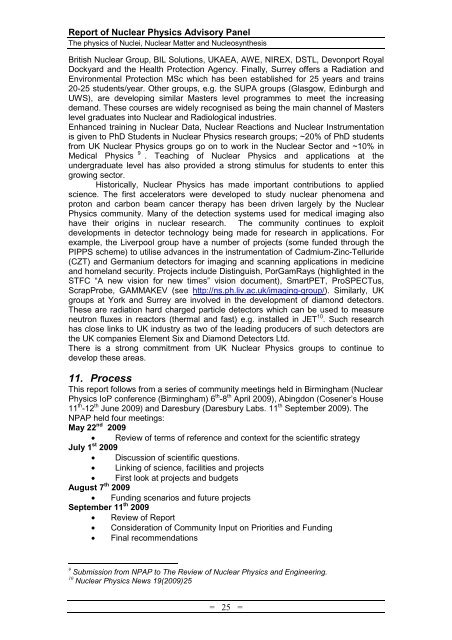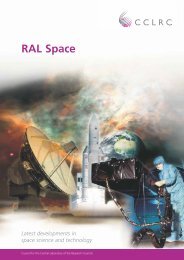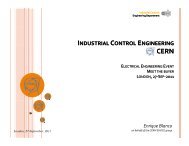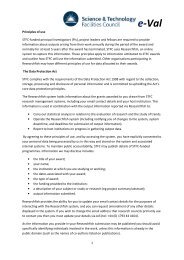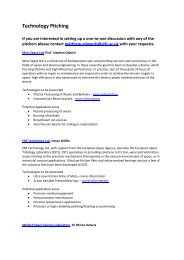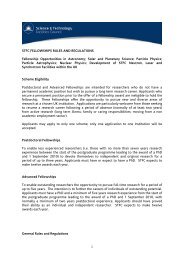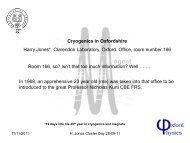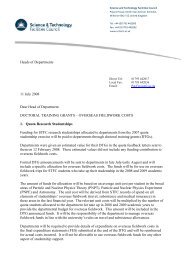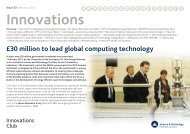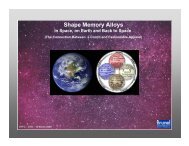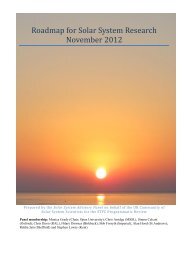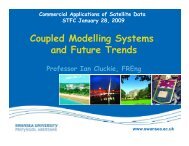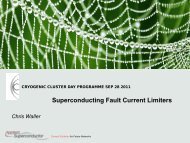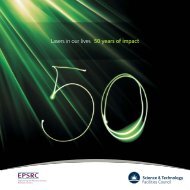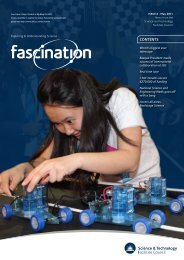Nuclear Physics Advisory Panel (NPAP) report (PDF-3.8 MB) - STFC
Nuclear Physics Advisory Panel (NPAP) report (PDF-3.8 MB) - STFC
Nuclear Physics Advisory Panel (NPAP) report (PDF-3.8 MB) - STFC
You also want an ePaper? Increase the reach of your titles
YUMPU automatically turns print PDFs into web optimized ePapers that Google loves.
Report of <strong>Nuclear</strong> <strong>Physics</strong> <strong>Advisory</strong> <strong>Panel</strong><br />
The physics of Nuclei, <strong>Nuclear</strong> Matter and Nucleosynthesis<br />
British <strong>Nuclear</strong> Group, BIL Solutions, UKAEA, AWE, NIREX, DSTL, Devonport Royal<br />
Dockyard and the Health Protection Agency. Finally, Surrey offers a Radiation and<br />
Environmental Protection MSc which has been established for 25 years and trains<br />
20-25 students/year. Other groups, e.g. the SUPA groups (Glasgow, Edinburgh and<br />
UWS), are developing similar Masters level programmes to meet the increasing<br />
demand. These courses are widely recognised as being the main channel of Masters<br />
level graduates into <strong>Nuclear</strong> and Radiological industries.<br />
Enhanced training in <strong>Nuclear</strong> Data, <strong>Nuclear</strong> Reactions and <strong>Nuclear</strong> Instrumentation<br />
is given to PhD Students in <strong>Nuclear</strong> <strong>Physics</strong> research groups; ~20% of PhD students<br />
from UK <strong>Nuclear</strong> <strong>Physics</strong> groups go on to work in the <strong>Nuclear</strong> Sector and ~10% in<br />
Medical <strong>Physics</strong> 9 . Teaching of <strong>Nuclear</strong> <strong>Physics</strong> and applications at the<br />
undergraduate level has also provided a strong stimulus for students to enter this<br />
growing sector.<br />
Historically, <strong>Nuclear</strong> <strong>Physics</strong> has made important contributions to applied<br />
science. The first accelerators were developed to study nuclear phenomena and<br />
proton and carbon beam cancer therapy has been driven largely by the <strong>Nuclear</strong><br />
<strong>Physics</strong> community. Many of the detection systems used for medical imaging also<br />
have their origins in nuclear research. The community continues to exploit<br />
developments in detector technology being made for research in applications. For<br />
example, the Liverpool group have a number of projects (some funded through the<br />
PIPPS scheme) to utilise advances in the instrumentation of Cadmium-Zinc-Telluride<br />
(CZT) and Germanium detectors for imaging and scanning applications in medicine<br />
and homeland security. Projects include Distinguish, PorGamRays (highlighted in the<br />
<strong>STFC</strong> “A new vision for new times” vision document), SmartPET, ProSPECTus,<br />
ScrapProbe, GAMMAKEV (see http://ns.ph.liv.ac.uk/imaging-group/). Similarly, UK<br />
groups at York and Surrey are involved in the development of diamond detectors.<br />
These are radiation hard charged particle detectors which can be used to measure<br />
neutron fluxes in reactors (thermal and fast) e.g. installed in JET 10 . Such research<br />
has close links to UK industry as two of the leading producers of such detectors are<br />
the UK companies Element Six and Diamond Detectors Ltd.<br />
There is a strong commitment from UK <strong>Nuclear</strong> <strong>Physics</strong> groups to continue to<br />
develop these areas.<br />
11. Process<br />
This <strong>report</strong> follows from a series of community meetings held in Birmingham (<strong>Nuclear</strong><br />
<strong>Physics</strong> IoP conference (Birmingham) 6 th -8 th April 2009), Abingdon (Cosener’s House<br />
11 th -12 th June 2009) and Daresbury (Daresbury Labs. 11 th September 2009). The<br />
<strong>NPAP</strong> held four meetings:<br />
May 22 nd 2009<br />
• Review of terms of reference and context for the scientific strategy<br />
July 1 st 2009<br />
• Discussion of scientific questions.<br />
• Linking of science, facilities and projects<br />
• First look at projects and budgets<br />
August 7 th 2009<br />
• Funding scenarios and future projects<br />
September 11 th 2009<br />
• Review of Report<br />
• Consideration of Community Input on Priorities and Funding<br />
• Final recommendations<br />
9 Submission from <strong>NPAP</strong> to The Review of <strong>Nuclear</strong> <strong>Physics</strong> and Engineering.<br />
10 <strong>Nuclear</strong> <strong>Physics</strong> News 19(2009)25<br />
= 25 =


